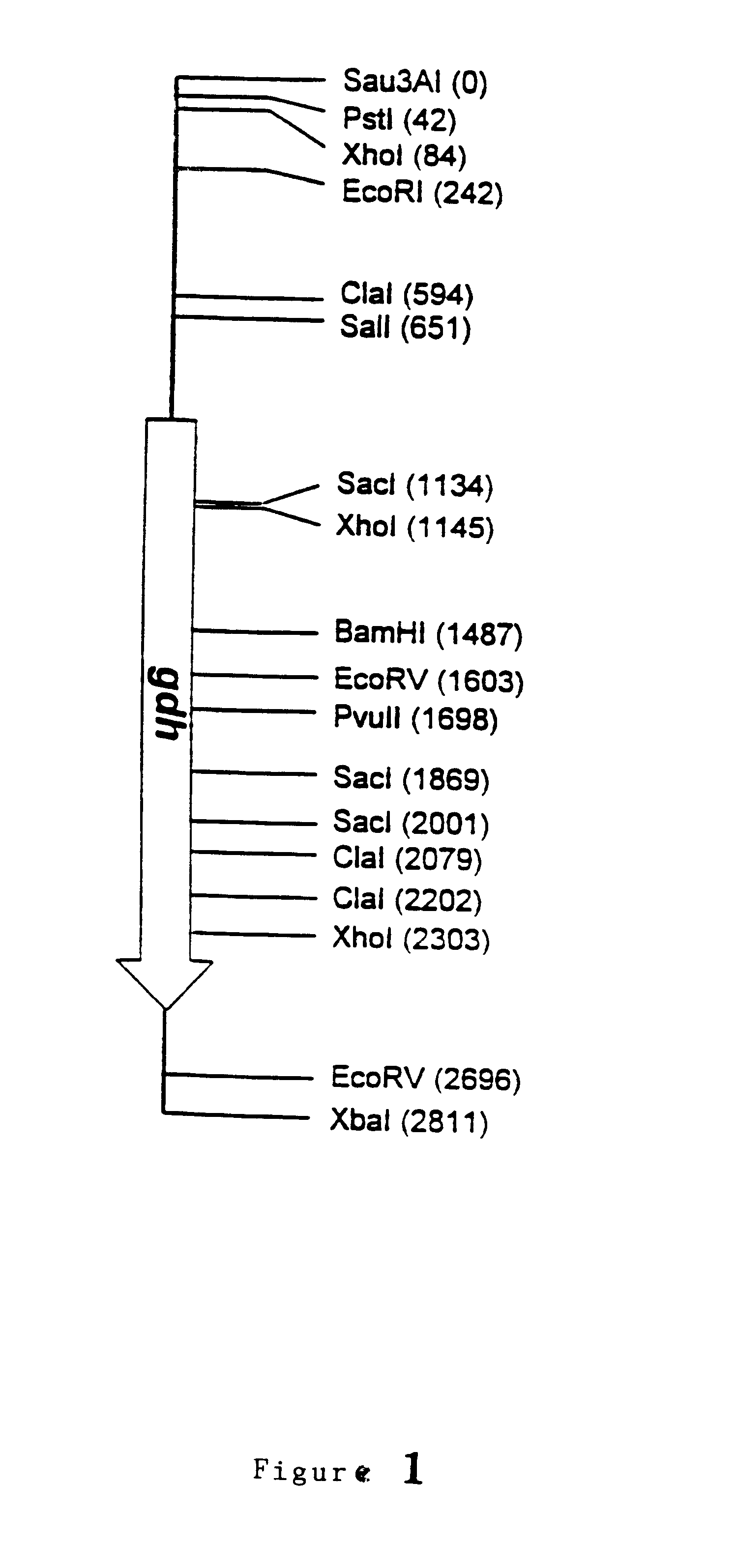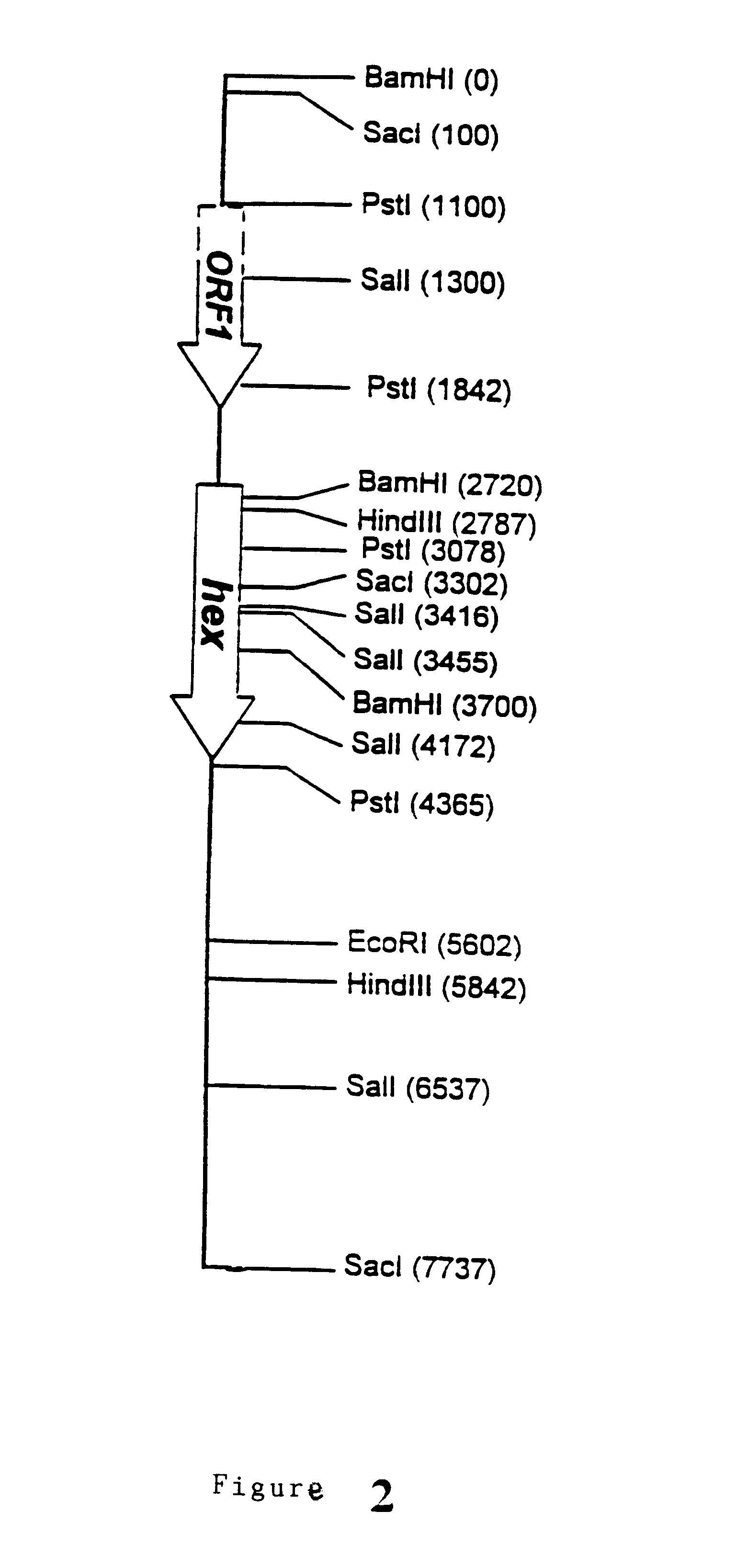Promoters of the genes glutamate dehydrogenase beta-N-acetylhexosaminidase and gamma-actin and their use in filamentous fungi expression, secretion and antisense systems
a technology of glutamate dehydrogenase and beta-n-acetylhexosaminidase, which is applied in the field of promoters of the genes glutamate dehydrogenase beta-n-acetylhexosaminidase and gamma-actin, can solve the problem that the promoter may not be efficiently recognized by the said fungi, and achieve the effect of eliminating undesirable enzyme activity
- Summary
- Abstract
- Description
- Claims
- Application Information
AI Technical Summary
Benefits of technology
Problems solved by technology
Method used
Image
Examples
example 2
2.1. Cloning and Characterization of the hex Gene of P. chrysogenum
The presence of a major protein which after purification and characterization was found to be the enzyme .beta.-N-acetylhexosaminidase was determined in the P. chrysogenum mycelium obtained from industrial fermentation under conditions of penicillin G production. The amino acid sequence of the amino terminal end of the purified protein was determined by Edman's degradation method, two different sequences being obtained:
(A) Ala-Pro-Ser-Gly-Ile-His-Asn-Val-Asp-Val-(His)-Val-Val-(Asp)-Asn-(Asp)-Ala-(Asp)-Leu-Gln-Tyr-(Gly) (SEQ ID NO.:9)
(B) Val-Gln-Val-Asn-Pro-Leu-Pro-Ala-Pro-(Arg)-(Arg)-Ile-(Thr)-???-(Gly)-(Ser)-(Ser)-(Gly)-(Pro)-(Ile / Thr)-???-(Val) (SEQ ID NO.:10)
On the basis of these sequences, and assuming the codon usage trend which exists in a series of P. chrysogenum genes, the following combinations of synthetic oligonucleotides were designed:
(I) 5' TCGACGACGTGSACGTCSACGTTGTGGATGCC 3' (SEQ ID NO.:11)
(II) 5' CCGTA...
example 3
3.1. Cloning and Characterization of the Act Gene of P. chrysogenum
The act gene of P. chrysogenum was cloned using the DNA library and the procedures described in Example 1. In this case the hybridization was performed with an 888 bp NcoI-ClaI fragment originating from the act gene of A. nidulans (Fidel et al. (1988), Gene 70: 283-293). A total of 10 positive clones were purified and their DNA was then digested with a series of restriction endonucleases and analysed by the Southern blot technique. In this way the act gene was identified in a 5.2 kb BamHI fragment, a 4.9 kb EcoRI fragment and a 5.9 kb HindIII fragment. The HindIII fragment was subcloned in both orientations in the plasmid pBluescript I KS(+) (Stratagene), generating the plasmids pALP298 and pALP299. The subcloning of the EcoRI fragment in the plasmid pBluescript I KS(+) (Stratagene) in both orientations generated the plasmids pALP315 and pALP316. The restriction map of the DNA region which includes the act gene is sh...
example 4
4.1. Cloning and Characterization of the Act Gene of A. chiysogenum
With the aim of cloning the gdh gene of A. chrysogenum, a DNA library was constructed in the phage vector .lambda.GEM12, as described in Section 1.1 of Example 1. The phage titre obtained was 50 pfu / .mu.l (a total of 25,000 pfu) in E. coli LE392 and 41 pfu / .mu.l (a total of 20,500 pfu) in E. coli NM539. This meant that about 82% of the phages were carrying an exogenous DNA fragment and that an A. chrysogenum DNA library had been obtained with 99.999% probability. After this series of theoretical verifications had been carried out, E. coli NM539 was infected and the complete DNA library was spread on 3 Petri dishes of 150 mm diameter (about 7,000 pfu / Petri dish), collected in 50 ml of SM plus 2.5 ml of chloroform, and kept at 4.degree. C. In this way a sufficient and representative volume of recombinant phages (2,100 pfu / .mu.l) ready to be plated out at any time was available.
About 20,000 pfu were spread on 2 Petri di...
PUM
| Property | Measurement | Unit |
|---|---|---|
| temperature | aaaaa | aaaaa |
| temperature | aaaaa | aaaaa |
| diameter | aaaaa | aaaaa |
Abstract
Description
Claims
Application Information
 Login to View More
Login to View More - R&D
- Intellectual Property
- Life Sciences
- Materials
- Tech Scout
- Unparalleled Data Quality
- Higher Quality Content
- 60% Fewer Hallucinations
Browse by: Latest US Patents, China's latest patents, Technical Efficacy Thesaurus, Application Domain, Technology Topic, Popular Technical Reports.
© 2025 PatSnap. All rights reserved.Legal|Privacy policy|Modern Slavery Act Transparency Statement|Sitemap|About US| Contact US: help@patsnap.com



